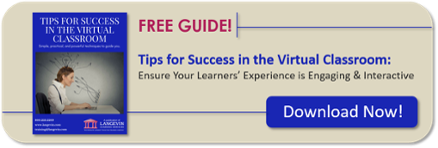
In a typical training course, learners spend significant amounts of time completing skill-based activities and exercises. During those exercises, or upon completion of them, each learner should receive feedback on their performance. In a traditional instructor-led course, the feedback process is fairly straight-forward. In virtual training, however, the process of giving and receiving quality feedback might pose a few challenges.
Having delivered virtual training for a few years, I’ve identified three challenges to providing feedback in the virtual classroom. Keep reading for some effective workarounds.
Challenge: Delivering personalized feedback
One-on-one or small group communication can be a bit more challenging in the virtual classroom. In most cases, the communication is openly broadcast to the entire group of learners. This could pose a challenge when attempting to deliver personalized feedback to an individual or small group.
Fortunately, most platforms have tools like private chat and breakout rooms. To keep the feedback personalized, have a private chat conversation with individual learners. Or, if you must give feedback to multiple groups, try using the breakout room function where only the members of each group are present.
As another option, divide the whiteboard into sections for each small group, or give multiple chat pods a try. I find these techniques also work well when you want your learners to deliver constructive feedback to each other.
Challenge: Encouraging trainees to provide constructive feedback
In both the traditional and virtual classroom setting, the most logical person to deliver feedback is the instructor. While this feedback approach does indeed work, it’s also a good idea to have variety. One option involves the learners giving feedback to each other—peer-to-peer feedback.
As with any training activity, this peer feedback approach must be set up and positioned the right way to be effective. In the virtual environment, the learners may be a bit shy because they’ve never seen or met their peers on the other end of the audio line. Or, some learners may feel they don’t have the appropriate skillset to give quality feedback.
Thankfully, there are workarounds to these issues. As virtual trainers, we should always be building rapport with our learners, both early on and continuously. The incorporation of icebreakers within your virtual course is a good way to do this. An icebreaker allows learners to get more comfortable with each other, increasing their comfort level delivering peer-to-peer feedback.
To remedy the perception of not having the appropriate skillset, always provide your learners with a performance checklist before they are tasked with offering feedback to their peers. This checklist can be part of their electronic manual or downloaded via the file share tool which is typically available on most virtual platforms. A well-designed checklist should provide a specific list of things to do, as well as a list of things to avoid, when delivering effective feedback.
Lastly, you should encourage peer feedback in a group setting within the virtual classroom. Facilitating the peer-to-peer feedback in this manner allows the trainer to oversee the process and provide additional feedback if necessary.
Challenge: Delivering carefully planned feedback
The way in which feedback is delivered in the virtual classroom requires more planning compared to the traditional classroom. The approach depends largely on both your timing constraints and the tools that will be used.
To address this particular challenge, you need to be proactive about how the feedback will be delivered, consider what tools will be required, and prepare effective supplemental materials well ahead of time (if they will be used).
Let’s say you are using a whiteboard for feedback purposes, and that whiteboard will be divided into sections. It’s a good best practice to prepare a slide beforehand so it can be displayed on the whiteboard. Or, if you plan to use multiple chat pods for peer feedback, it’s helpful to create a separate layout ahead of time that contains the number of chat pods required. Likewise, if a performance checklist is required for feedback purposes, it needs to be prepared in advance and included in the participant materials or loaded into a file share pod so it can be distributed to the learners when needed.
Time constraints in the virtual classroom often limit the spontaneous feedback that occurs more easily in the traditional classroom. To help with this, always provide a list of specific questions or criteria so the people providing feedback know exactly what they should be assessing. This list should be prepared in advance, complete with clear instructions and time limits given for each feedback opportunity.
Despite these few challenges, it is indeed possible to give and receive quality feedback in the virtual classroom. Just be sure to account for a few considerations like careful planning and maximizing the use of the tools within your virtual platform. When these things are considered, the feedback approach will be successful.
What challenges have you faced when providing feedback in the virtual classroom? What have you done to overcome those challenges?
Take your virtual classroom courses to the next level with the Maximizing Engagement in the Virtual Classroom workshop. Learn how to leverage the tools in your virtual platform to create powerful, interactive, and engaging virtual learning experiences.
Note: This post is part of a workshop intersession activity. As such, it is monitored in a slightly different manner than the other blog posts on our website. If you are not a participant in the applicable workshop, but have a question you would like answered, please feel free to contact us.



289 Responses to “Overcoming 3 Challenges to Providing Feedback in the Virtual Classroom”
Fundamentally virtual classrooms present new challenges however our in-class lessons have also taught us to adapt and execute for better outcomes.
Quality feedback no matter the platform and I agree slightly more challenging in the virtual world or reality we currently live in, still requires us to be in continuous rapport.
If you think about the very definition of Rapport (Merriam-Webster)
: a friendly, harmonious relationship
especially : a relationship characterized by agreement, mutual understanding or empathy that makes communication possible or easy
A good understanding of someone and the ability to communicate well with them.
What we do know is that Rapport is by being; sincere, honest, genuine, curious, and interested a good rapport through all the tools required for the following;
1. Delivering personalized Feedback in one-on-one environments can be challenging however private chats (private chat tool) and for groups (breakouts) is a way to help deliver personalized feedback.
2. Encouraging trainees constructive Feedback works and is most logical for both Virtual & In-Class to deliver back to the facilitator. However in the Virtual environment it can be challenging to have inclusivity mostly because they don’t know or possibly have not built rapport within their new environment. Performance checklist is a great suggestion prior to offering feedback however this is great in a group setting.
3. The way in which we deliver Feedback is important and I agree; does require more planning than a traditional environment. Challenges with time and possibly tools (maximize effectiveness) can be the difference in quality feedback in the virtual classroom.
Great article on breaking down the challenges and then let’s not assume we have simply built rapport from the start but keep it continuous using engagement methodologies. If we produce and encourage simultaneous interaction utilizing a combination of active and passive tools to encourage engagement through physical and cognitive engagement we can provide a virtual platform to establish and build on rapport for the learners and facilitators to overcome challenges and to deliver maximized engagement in the Virtual Classroom.
This Article is very interesting and it brought out some important facts that will help me prepare for my future trainings. In addition, the techniques discussed are ones to consider for future trainings.
The groups I train are generally employees from the same group, so the peer feedback tool will be a great asset in those instances when I have a group with pre-existing relationships. As far as delivering one on one (trainer-trainee) feedback, especially in groups that are not already familiar with eachother, I think opening a line through private chat will be helpful to both the trainee and myself, in that it would offer me insight into things I should focus on more. It’s easy to gloss over things when you are familiar with them (aka when you give the same class twice a week), and generally in an IRL classroom, you can read the room to see who is or isn’t following along, but in the virtual classroom, it becomes more difficult. Providing that direct channel may encourage people who are not inclined to speak up in the broader classroom to raise issues directly to me. The tools outlined in this class (and this article) will be a great asset to ensure I’m making the feedback as accessible as possible to everyone, while respecting their comfort level.
Presently, I do not deliver virtual Training Sessions, but I have found the “Maximizing Engagement in the Virtual Classroom” to be a very eye-opening course. Regarding the Blog, “Overcoming the 3 Challenges of Providing Feedback”, the Personal Chats and Breakout seemed to be the most logical means of delivering personal feedback (Facilitator to Participant). The Peer-to-Peer Feedback option, personally, struck me as a ‘Wow Moment’, particularly because the chances of the participants knowing each other is slim and that could make delivering feedback to a “stranger” a bit uncomfortable. But the explanation and example on how to provide this peer-to-peer feedback was a seemingly very strong suggestion and very doable.
As with all else in virtual trainings and elearnings, a feedback interaction has to be carefully planned ahead of time. The bonus is that by creating a checklist or job aid for this activity, it can also be used later for self-assessments of the target skill on-the-job.
I do a lot of training and this article has really validated some of the adjustments I have made transitioning in-person training material to virtual training material. It’s nice to know I am on the right path for providing an optimal virtual training environment.
I really enjoyed reading about how to deliver personalized feedback in the virtual environment. This will help to make sure individual questions are addressed and any misunderstanding are recognized quickly and effectively. This will prevent individuals from “checking out” when they feel their concerns or voices are not heard.
Great tips for using the virtual classroom tools to create a safe environment that provides learners timely and constructive feedback.
This blog article was very helpful by providing suggestions to help make feedback more personal, private, and structured for online learners. Many times feedback is skipped when running short of time, but if you plan it into the overall course structure and make room for it throughout the course, the learner receives a more valuable training experience. Great ideas, will definitely take these back to my organization.
Great article. The tip for the list of questions to solicit peer to peer feedback is a great idea. I also liked learning that peer to peer feedback can be more effective then instructor to peer feedback. I will need to add more of that in my training.
I really liked this article. Feedback in any training whether virtual or in person is vital. Like most things with training, timing and execution of that feedback is of the utmost importance.